The Sichuan Question – Chengdu or Chongqing?
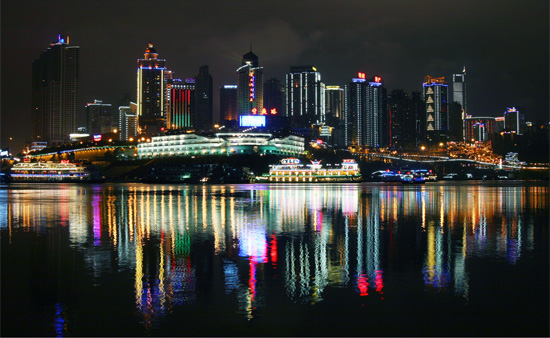 May 17 – Here at China Briefing we have been putting a lot of focus on the rising land and labor costs across China – particularly in more well-known first tier east coast and southern cities such as Beijing, Shanghai and Guangzhou. While prices in China’s rural regions are rising as well, the country’s inland cities still offer significant savings when compared with those along the coast – but which inland city is the best option for your business?
May 17 – Here at China Briefing we have been putting a lot of focus on the rising land and labor costs across China – particularly in more well-known first tier east coast and southern cities such as Beijing, Shanghai and Guangzhou. While prices in China’s rural regions are rising as well, the country’s inland cities still offer significant savings when compared with those along the coast – but which inland city is the best option for your business?
In this article we take a look at and compare the land, labor, and logistics costs, as well as the investment facilities, offered by two of the leading options in inland China – Chengdu, the capital of Sichuan Province, and its close neighbor Chongqing.
In fact, many big name manufacturers are already located in the region; Hewlett-Packard and Cisco have bases in Chongqing, while Intel’s assembly and testing facility and Motorola’s research and development center are located in Chengdu.
Land: factory rental
The first motivator cited by companies locating inland is quite often land cost. Prices for all types of land and facilities – residential, retail, logistics, and factory – are rising quickly in cities in all parts of the country. Chengdu and Chongqing are no exception, and standard factory rental costs as of the fourth quarter 2010 were a respective RMB13.6 and RMB12.8 per square meter per month. According to CB Richard Ellis (CBRE), inland standard factory prices have been rising between 0.5 percent and 2 percent annually over the past five years.

Labor: salary costs
Minimum wage
While many international investors pay salaries well above minimum wage and minimum wage cannot cater to managers and more senior personnel, this standard (taking overtime and mandatory social welfare contributions into account) is nonetheless the go-to figure when comparing labor costs for SMEs. Comparing the current legally permissible minimum salaries between cities gives a rough estimate of the potential labor savings of operations in inland cities. In this regard, Chengdu’s minimum wage of RMB850 per employee per month offers slight cost savings over Chongqing at RMB870 per employee per month.

Overtime
Many factories will employ staff on an overtime basis in shifts, as it makes economic sense to do so. China’s labor laws indicate a premium of 150 percent for normal overtime.
Mandatory welfare
Mandatory welfare payments to Chinese employees (including pension, unemployment, medical insurance and housing) are a very important, and sometimes overlooked, aspect of assessing labor costs and rates vary from city to city. There are also variances in minimum employer welfare contributions based on the employee’s residence registration, or hukou, as well as based on how much the employee chooses to personally contribute to the housing fund (distinguished in the table below as low and high contributions).

So while at first glance Chengdu appears to offer slight labor cost savings over Chongqing with regards to minimum wage, Chengdu loses this advantage by having a slightly higher minimum employer welfare contribution rate of between 35.72 percent and 41.72 percent compared to Chongqing’s range of between 31 percent and 39 percent.
Transportation
To estimate the influence of export transportation costs, we have obtained quotes for transporting a standard container from Chengdu and Chongqing to the nearest and most commonly used coastal ports: Shanghai and Shenzhen. As illustrated in the chart below, Chongqing is the cheaper option whether shipping to Shanghai or Shenzhen.

Total operating costs: land, labor, and transportation
Taking the cost information compiled above and assuming a 2,000 square meter factory rental, 100 employees earning 10 percent above minimum wage, the “low” end of each city’s employer welfare contribution, and exports of 25 containers a month sent to the cheapest nearby port, Chongqing offers operational cost savings of nearly 5 percent over neighboring Chengdu. The bulk of these savings are made through Chongqing’s cheaper transportation costs of RMB6,090 per container to Shenzhen versus costs of RMB6,518 per container from Chengdu to Shanghai.
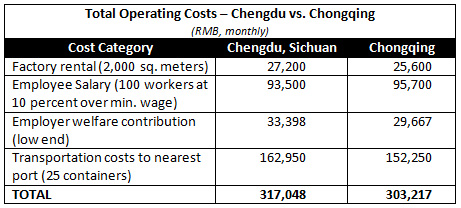
Please keep in mind that these are rough estimations for operational costs in the two cities and can vary depending on quite a number of factors. We encourage you to do your own calculations, based on the precise geographic locations you are considering and your company’s specific circumstances.
However, since the cost comparisons are so close, a more in-depth look at the economic, infrastructure, and investment facilities available in Chengdu and Chongqing is necessary to better understand these two attractive inland China destinations.
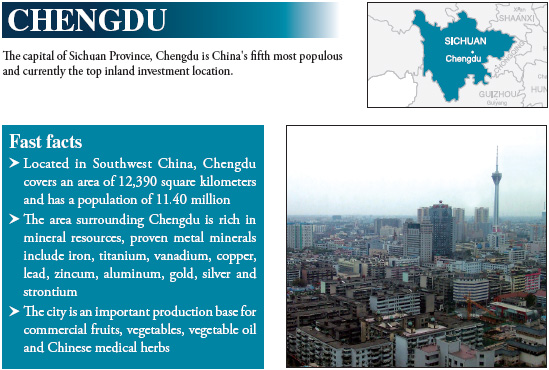
Infrastructure
Road
There are expressways linking Chengdu to cities across China including Beihai, Shanghai, Xi’an, Lhasa, and Chongqing.
Railways
Chengdu is the largest railway hub in Southwest China, linking four trunk railways to the cities of Chongqing, Baoji, Kunming and Daxian. There are four cargo railway stations in Chengdu, of which the Chengdu Eastern Station is the largest in Southwest China.
Air
The Shuangliu International Airport has direct flights to Hong Kong, Bangkok, Singapore, Seoul, Tokyo, Fukuoka, Katmandu, Osaka, Paris, and Kuala Lumpur as well as flights to all major domestic airports.
Ports and waterways
Railway lines link Chengdu to ports on the eastern coast such as Shanghai, Shenzhen, Tianjin, Qingdao, and Lianyungang. There are also expressways connecting the city to local ports at Leshan, Luzhou, and Chongqing which are all within 360 kilometers of Chengdu.
Economy and investment climate
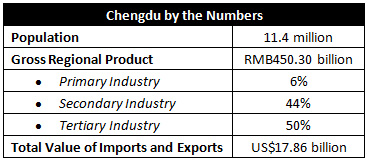
Chengdu is the state designated trade and finance center for the southwest as well as a communications center. Chengdu has six pillar industries: high-tech, manufacturing (including aviation technologies), biological engineering and pharmaceuticals, food processing, metallurgy and building materials, and petrochemical processing. The city’s manufacturing industry is driving its economy forward, with major manufacturing products such as automobiles and motorcycle spare parts, aircraft parts, engineering machinery, lathe tools, electrical engineering and electric apparatus, general spare parts, and agricultural machinery.
Chengdu has a strong record at attracting foreign investment. Intel, the world’s largest chip maker, invested US$525 million in two assembly and testing facilities in the city. Other foreign companies with investments in Chengdu include Nokia, Sony, Toyota, Motorola, Microsoft, Ericsson, Lafarge, Volkswagen, DHL, Texas Instruments and Astellas.
Chengdu was one of the five cities to be named as pilot reform cities by the Chinese government. This means that decisions of policy and economic strategy for the city now reside in the hands of the local government rather than Beijing, giving the local government and businesses a far greater say in the economic development of the city.
Development zones
Chengdu Hi-tech Industrial Development Zone
The zone consists of the southern and western zones and also includes two export processing zones. The three major industries are electronic information, bio-pharmaceuticals, and precision machinery manufacturing. FIEs with a presence in the zone include Intel, Molex, Motorola, Corning, and Sony.
The Chengdu Hi-tech Zone focuses on R&D and manufacturing of high-tech industrial products, especially micro-electronics-oriented IT (software included), bio-pharmaceutical industry focusing on traditional Chinese medicine, precision mechanical processing, modern food processing, new materials, and environmental protection. There is also an export processing zone (EPZ) in both the southern area and the western area. The southern EPZ covers a total area of 0.6 square kilometers.
Chengdu Economic and Technological Development Zone
Approved as a state-level development zone in February 2000, the CETDZ lies 13.6 kilometers east of Chengdu and is the transportation and communication hub. CETDZ is 28 kilometers away from Chengdu Shuangliu International Airport, one of the country’s four major airports. Chengdu-Chongqing Expressway is to its north, and the Chengdu-Kunming Railway to the west. The Cheng-Long Highway, the City-ring Expressway and Chenghuan Highway run through the zone. The Chengdu-Chongqing Expressway goes directly to Chongqing Jiulong Harbor and Luzhou International Freight Dock.
CETDZ focuses on machinery, electronics, metallurgy, building materials, medicine, and food processing. Investment is encouraged in the following: machinery, automobile, motorcycles, electronics, optical products, informational technology, new materials, environmental protection, biomedicine, food processing, new building materials, refined chemistry, aviation and space industry and infrastructure building.
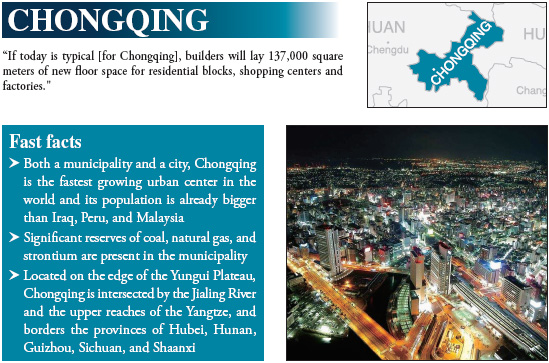
Infrastructure
Road
There are five major highways that run through Chongqing, the most important of which is the Chengdu-Chongqing expressway that links the two powerhouses of West China. On expressways, the trip from Chongqing to Wuhan takes eight and a half hours, and from Chongqing to Shanghai takes 17 hours.
Railways
There are currently three major national lines running through Chongqing. The municipal government hopes several new lines under construction will make the city a national railway hub by 2017. The flagship project is a new high-speed link to Shanghai which will cut the journey time from 42 hours to just eight hours. According to local authorities, the city will have eight containerized rail lines by 2020.
Air
Chongqing Jiangbei International Airport is located 21 kilometers to the north of the city. There are international flights to Hong Kong, Dusseldorf, Munich, Tokyo, Nagoya, and Seoul.
Ports and waterways
Lying on the upper reaches of the Yangtze River, Chongqing’s port can handle ships of up to 12,000 deadweight tons (depending on which of the five terminals are used). The Three Gorges Dam has reduced the journey time to Shanghai as it has raised navigable water levels along the river.
Economy and investment climate
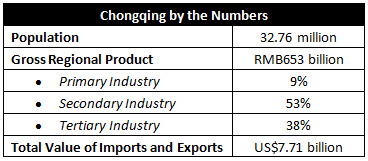
Chongqing is China’s fourth largest center for motor vehicle production. The municipality is expected to turn out 2.6 million vehicles a year by 2020, an output that could account for as much as 15 percent of the national total. Chongqing is very open to FDI, FIEs and foreign trade. Global Fortune 500 companies with operations in the municipality include Danone, Carrefour, HSBC, Ericsson, Honda and Ford.
Development zones
Chongqing Economic and Technological Development Zone
CETDZ was the first state-level development zone to be approved in southwest China. Located conveniently in Nanping, the zone covers an area of 9.6 square kilometers. It lies adjacent to the Chongqing Yangtze River Bridge in the north. The park is connected with downtown Chongqing and is three kilometers from the Chongqing railway station, five kilometers from the Chongqing passenger wharf, and 28 kilometers from Chongqing Airport.
The zone comprises five main areas, namely information industry zone, Dangui industrial zone, Huilong industrial zone, comprehensive trading block, and Nanhu and Luochangwan residential areas. Key industries in the zone include automobiles and auto parts, IT, pharmaceuticals and biochemical.
Chongqing Hi-Tech Industrial Development Zone
The Chongqing Hi-Tech Industrial Development Zone contains a 12 square-kilometer area of industrial parks. The zone is aimed at a range of high-tech and other modern industries, but most of the companies have specialized in just two areas, namely electronic information products and auto components manufacturing.
Other development zones include Chongqing Chemical Industrial Park, Chongqing New North Zone, Chongqing Export Processing Zone, and Jianqiao Industrial Park.
Portions of this article were extracted from China Briefing’s March 2011 issue titled “Operational Costs of Business in China’s Inland Cities.” To purchase the full version, priced at US$10 for immediate PDF download, please click here.
This article was written with the help of Dezan Shira & Associates. For legal establishment, tax or related advice about investing in Chengdu or Chongqing please contact the firm at info@dezshira.com or visit www.dezshira.com. The firm’s Principal, Chris Devonshire-Ellis, will be speaking about investments in Chongqing at the “Gateway to the West” Euromoney conference on June 14. For details about this event, please contact Zach Reff at Euromoney at zach.reff@euromoneyasia.com.
Related Reading
 Doing Business in China
Doing Business in China
The successor to our “China Business Bible,” this new, completely updated 156-page book covers all aspects of business in China, from the different types of legal structure, the full tax implications, human resources and labor issues, including cost analysis, intellectual property matters, a complete overview of China’s free trade and development zones, and on-going compliance issues such as tax filings and license renewals, audit and closure issues.
 Business Guide to West China
Business Guide to West China
172 pages. This book is a detailed overview of West China, including the provinces of Gansu, Guizhou, Ningxia, Shaanxi, Sichuan, Tibet, Xinjiang and Yunnan, and includes detailed introductions to the key cities of Chengu, Chongqing, Kashgar, Kunming, Lanzhou, Lhasa, Guiyang, Urumqi, Xining and Yinchuan.
 Business Guide to China’s Second and Third Tier Cities
Business Guide to China’s Second and Third Tier Cities
217 pages. The guide book is the definitive guide to China’s second and third-tier cities. It provides a thorough and in-depth analysis, regional intelligence and overviews of fifty of China’s emerging cities, featuring economic data, infrastructure and investment climate reviews, and a directory to development zones, business associations, media and major hotels in all locations.
- Previous Article Moet Invests In Ningxia Sparkling Wines
- Next Article China-India Business Update: May 18


























